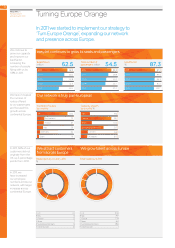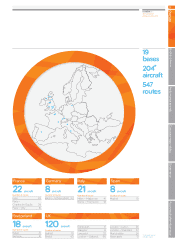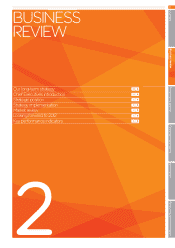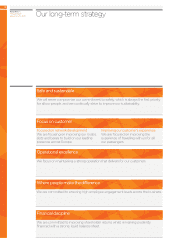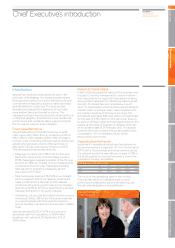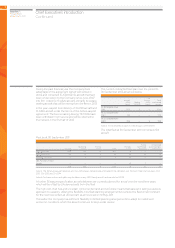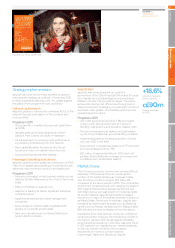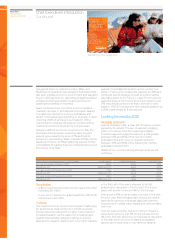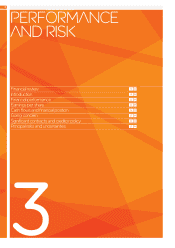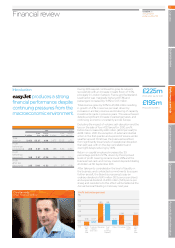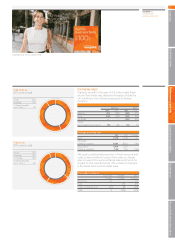EasyJet 2011 Annual Report Download - page 16
Download and view the complete annual report
Please find page 16 of the 2011 EasyJet annual report below. You can navigate through the pages in the report by either clicking on the pages listed below, or by using the keyword search tool below to find specific information within the annual report.
14
easyJet plc
Annual report
and accounts 2011
Chief Executive’s introduction
Continued
has gained share on routes to London, Milan and
Madrid as competitors have retreated. Switzerland has
also seen a stable economic environment and easyJet’s
focus in 2011 has been on defending its leading position
at Basel and Geneva whilst increasing its focus on
passengers travelling on business.
Spain continues to be one of the most competitive
markets in Europe. In 2011 easyJet refocused capacity
to enable the network to improve profitability and
attract more passengers travelling on business. In Spain
more than 60% of air travel is purchased in offline
channels and consequently easyJet is implementing
measures to improve its presence in these areas.
Despite a difficult economic environment in Italy the
short-haul intra-European market remains buoyant
easyJet grew capacity by around 11% as it built its
presence in selected key Italian markets of Milan, Rome,
Naples and Venice. At Milan Malpensa easyJet further
consolidated its leading share as Lufthansa announced
the closure of its base.
easyJet consolidated its position as the number two
airline in France and increased its capacity by 29% as it
continued with its strategy to build its position as the
alternative airline to Air France in major French airports.
easyJet’s share of the French short-haul market is now
12%. easyJet also announced that it intends to open
bases in 2012 at Toulouse and Nice. easyJet already has
a 20% market share at these airports.
Looking forward to 2012
Hedging positions
easyJet operates under a clear set of treasury policies
agreed by the Board. The aim of easyJet’s hedging
policy is to reduce short-term earnings volatility.
Therefore easyJet hedges forward, on a rolling basis,
between 65% and 85% of the next 12 months
anticipated fuel and currency requirements and
between 45% and 65% of the following 12 months
anticipated requirements.
Details of our current hedging arrangements are set
out below:
Percentage of anticipated requirement / surplus hedged Fuel requirement US dollar requirement Euro surplus sale
Six months ending 31 March 2012 80% 80% 76%
Rate/$ per MT $950 per MT $1.60 €1.13
Full year ending 30 September 2012 73% 69% 71%
Rate/$ per MT $956 per MT $1.59 €1.13
Full year ending 30 September 2013 49% 46% 50%
Rate/$ per MT $979 per MT $1.61 €1.14
Sensitivities
– A $10 movement per metric tonne impacts the 2012
fuel bill by $5 million
– A one cent movement in £/$ impacts the 2012 profit
before tax by £3 million
Outlook
The macroeconomic environment remains challenging
for all airlines as weak consumer confidence across
Europe slows the rate at which higher fuel prices and
increased taxation can be passed on to passengers.
Against this backdrop easyJet is taking a cautious
approach to capacity deployment. As a result, capacity
in the first half of the year is planned to be flat
(adjusting for disruption in the first part of the prior
year), with growth of around 4% for the full year.
With around 45% of winter seats now sold, in line with
the prior year, first half passenger revenue per seat is
expected to grow by mid-single digits with planned
improvement in yields, bag charges and other ancillary
revenues.
Cost per seat excluding fuel and currency7 impact is
expected to grow by 2 to 3% for the full year and by
4% in the first half, assuming normal levels of disruption,
of the year driven by price increases at regulated
airports and investments in new revenue streams.
Example only. Not a current offer.


